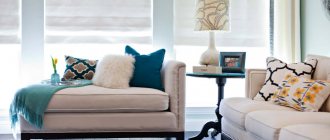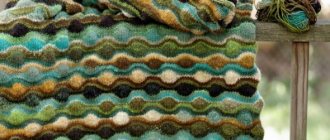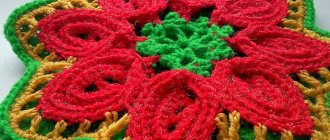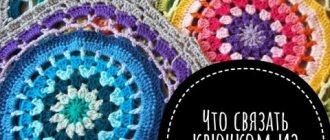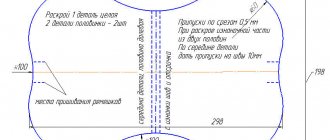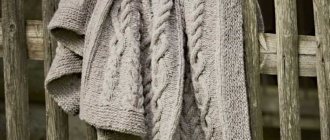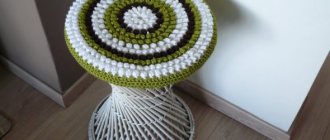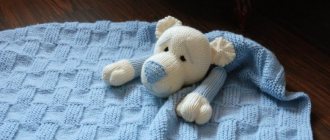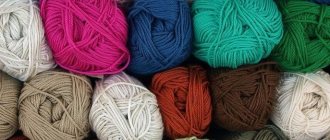Even a novice needlewoman can knit a pillow with knitting needles. This is also a great opportunity to practice knitting complex patterns with knitting needles. After all, when knitting large items, it is important to maintain the same knitting density. And if you have not yet reached this level, then training on simple things: hats, covers, caps is just the thing.
Knitted pillowcases for sofa cushions with braids
There can be a huge number of variations with braids for pillowcases on sofa cushions; for example, I’m posting several, for which I found specific diagrams and descriptions, and, of course, you can come up with different designs with similar patterns. They always look advantageous and are interesting to knit.
Beautiful pillows with spectacular braids
It is proposed to knit these beautiful bright pillows with cotton threads (50 g/73 m), knitting needles number 4.5.
Knitting density: 10 loops and 26 rows in a square of 10 x 10 cm, pillowcase size - 40.5 by 40.5 cm.
Description of knitting pattern with braids
Row 1: K1, (P2, K2) 3 times, P2, K1.
All purl rows: purl 1, (k2, purl 2) 3 times, knit 2, purl 1.
Row 3: cross 8 sts to the right (slip 4 sts onto an additional knitting needle while working, k1, p2, k1, from an additional knitting needle - k1, p2, k1). Cross 8 sts to the left (4 sts remove onto an additional needle before work, k1, p2, k1, from an additional knitting needle - k1, p2, k1).
Rows 5, 7, 9: same as 1st.
The back part is knitted with 2 x 1 elastic (k2, p1).
After all parts of the pillow are sewn, decorative strands need to be sewn over the seams along the entire perimeter.
How to make a decorative rope
- Cut six strands 244 cm long.
- Place the threads together and twist them to the right.
- Fold the resulting bundle in half and twist it again.
This cord is enough for two sides of the pillow. For the other two, you should make another tourniquet, apparently because a very large one is not convenient to weave.
Burgundy pillowcase
A very beautiful pattern for a pillowcase with intricate weaves in the center, simple braids and a rice pattern in between.
Green pillowcase with cords
The pillowcase is knitted with strands against the background of a rice pattern (alternating purl and knit), but there is no such pattern, I only selected an option for knitting a strand in the center.
And the “berries” are knitted as follows: make a loop twice from the front wall, then from the back, resulting in 4 loops from one.
Next, the 4th loop should be pulled through the 3rd, 2nd and 1st and discard the knitted loops from the right knitting needle.
Look at the pillow I knitted with braids using the intarsia technique.
Principles and techniques of making covers
Making knitted pillowcases with your own hands is different in that this handicraft is quite easy to do. Here, only the diagram with a description that corresponds to the relief present on a particular pillow is used. Knitting pillows can be an excellent teaching example for beginning knitters, especially if the pillow shape is a rectangle:
Before you start knitting, you need to measure the pillow you have chosen in order to knit the corresponding cover with knitting needles. Then, as usual, you need to knit a sample to determine the density of the fabric. In this case, knitting the sample must be done with the same knitting needles and relief that you have chosen for the main fabric. Using the same knitting needles and the same pattern, you then need to knit the cover itself. The pillowcase should have dimensions that are at least a centimeter larger than the pillow, otherwise it will shrink inside the cover and lose its shape. We start knitting with a set of P, and continue to knit the shape we need with the selected pattern. If you don't have enough yarn, knit the top half of the pillowcase, and cut the bottom half out of fabric of a suitable shade. Having finished knitting, fold both halves of the pillow face inward and sew them together, then turning them right side out. After this, you need to sew a zipper onto the open area of the cover:
If the selected relief allows, the product is knitted in one continuous strip. Having finished knitting, fold it in half, right side inward, and then sew it on the sides:
Patterns of knitted pillowcases with embossed patterns
Gray pillow
In modern style, gray, black and white are often used. And this version of a gray pillowcase is already known to many, it has been circulating on the Internet for a long time, but I still haven’t avoided it - I really like this pattern and its combination with the stockinette stitch.
Three pillows with embossed patterns
Three wonderful knitted pillowcases will look great in any color combination to suit your home decor.
Recommended yarn: 40% polyamide, 30% viscose, 15% silk, 15% cashmere; 75 m/50 g. Approximate consumption - 250 grams per pillow measuring 40 x 40 cm. Knitting needles No. 7.
Pillowcase with a beautiful pattern
Delicate color and a cute knitting pattern to match it. The diagram is divided into three parts, but I think everything is clear here.
Video lessons and master classes on knitting a pillow cover
Watch good video tutorials on knitting pillows.
Cushion Cover for Beginners
Knitted on the basis of a “granny square”. There are a lot of options for color combinations. The pillow is double-sided, you can turn it with the light side or the dark side. The pattern is knitted from the center. Yarn Pekhorka Children's New 50g/180m.
Why do we recommend this video for beginners? The granny square pattern is simple; you only need to know how to knit double crochets and chain stitches.
The video should load here, please wait or refresh the page.
Knitted pillows with rhombus pattern
Diamond knitted pillows look very nice. I like both options - in one, between the borders of the diamonds there is not a simple knitting, but rice (not indicated on the diagram), and in the second - double diamonds: two lines with facial loops, between which there are also purl loops.
Beautiful placement in the interior
Knitted pillows are a great way to add fresh colors to your interior. Their uniqueness also lies in the fact that for such products there is no need to select upholstery or a sofa cover (bed blanket) of the same tone.
A great idea for decorating a bedroom or living room would be a combination of knitted pillows with a blanket and poufs.
Since a light tone needs contrast, it is worth adding a pouffe-style pillow to the set, making it a smaller copy of the latter - in gray. The variety of patterns and colors is exactly what you need: such a sleeping place will always be special and beautiful.
If you want to choose knitted accessories to match the tone of the bedding, you should complement the bed with pillows of different sizes and shapes. The only thing worth considering is that the pattern can be repeated in only two pillows, otherwise the interior will become boring.
Pillows made of squares and zigzag stripes, made of bright multi-colored threads, perfectly decorate any (even the most ordinary) sofa without a cover. Moreover, such products always look impressive, even if the set consists of elements of different shapes and designs.
Made in the form of rollers, such products can replace the armrests of sofas that do not have side edges. Decorated around the edges with multi-colored fringe or without it, these pillows will decorate any sofa. They are relevant both in country style and in the interior of a country house.
Knitted pillows with a front fastener (or its imitation) can decorate a classic sofa with armrests. Made in different muted shades with different textured patterns, they will add variety to any interior without disturbing the harmony of the room, maintaining light and warmth.
A candy pillow with a relief pattern in the form of braids and stripes with ribbon ties is a great idea for a living room or children's room. Located near the armrest, it will not take up much space, but will indicate the originality of the style.
The uniqueness of the product lies in the fact that it is easy to put on and take off (just untie the ribbons). To ensure that the product fits harmoniously into the interior of the room, just choose the color of the ribbons.
This video shows how to knit a “Star” pillow from knitted yarn with your own hands.
Description of knitting pillows with honeycombs
It is better to knit such pillows from acrylic (85 g/137 m); for a product with a side of 45.5 cm you will need 2 skeins. The spoke number is five.
Knitting on 85 loops at a density of 18 loops for 24 rows (per area 10 x 10 centimeters).
Description of knitting the front part
Knit in the first row, purl in the odd row.
Row 3: (knit 3, slip one stitch as a purl) – repeat 13 times, purl 1, (knit 1, knit 1 from the bottom row) – 15 times, knit 2.
Row 5: (K3, slip one loop as a purl) – 13 times, P1, K2, (K1 from the bottom row, K1) – 14 times, K2.
Back of the pillow
In all front rows: knit 3, *slip 1 p. purlwise, knit 3*.
In the purl rows there are purl loops.
Colored pillow
An original flowery pillow for the sofa can be knitted from bright yarn, dyed sectionally. In this case, it is best to use yarn that is soft to the touch and resistant to abrasion.
A colored pillow can be made from section-dyed yarn.
Knitting density – stockinette stitch 10 x 10 cm, 18 sts and 24 r.
According to the size of the product, it will be a square, the side of which is 36 cm.
The best option is to take 2 skeins of yarn (100% acrylic 100 g/191 m) with half-meter circular knitting needles 5 mm.
Knitted openwork pillow covers
Openwork pillowcases are very elegant and beautiful. I've been paying attention to these patterns for a long time.
Here are some other pictures of interesting knitted pillows that I haven’t come across any more, but you can use any pattern you like.
Design selection
Choosing a style for a pillow can be very difficult because there are so many of them. You can take ready-made ideas from the Internet, or you can come up with something yourself. If we talk about the shape of the product, it can be as follows:
- Square or rectangular.
- Round or oval.
- Hexagonal.
- In the shape of a cylinder.
- In the form of any animal, like a toy.
- Transformable pillow.
Note! If there is a blanket in the house, then you can try to pick up yarn of the same color and make something like a set. If there is no blanket, then this is a reason to buy more threads and knit that too.
You can knit a pillow to match the blanket.
The design and color of the finished product depends only on the tastes and preferences of the craftswoman. But it is important that it fits into the overall design of the room.
Decorative knitted pillows with leaves
Such an incredibly beautiful pattern that it would be a pity to put such a pillow under your head, especially since it is knitted with light beige threads. Therefore, this is most likely a decorative option for interior decoration.
I did not find any recommendations on the composition of the thread, only that the knitting density should be approximately equal to 23 loops per 32 rows when knitting with number 3 knitting needles.
The pillow is knitted from the center on stocking and circular needles.
Cast on 8 stitches on double needles and knit in the round according to pattern A1.
Upon completion of knitting full repeat, there should be 128 loops on the knitting needles.
At the beginning of the row and every 32 loops, it is convenient to attach markers that should be moved as you work.
Next we knit in this way: * pattern A.2 (= 2 p.), 28 p. according to pattern A.3 (= 2 repeats of 14 p.) and pattern A.4 (= 2 p.) *, repeat 4 times . At the end of this stage there will be 240 stitches on the needles.
In the following rows: * pattern A.2 (= 2 sts), 56 sts according to pattern A.3 (= 4 repeats of 14 sts) and pattern A.4 (= 2 sts) * - 4 times.
We have an interesting version of a beautiful pillow with leaves forming a flower in our article about knitting a blanket with knitting needles from squares in the same pattern.
Round pillow
Materials for work:
- Yarn (100% cotton) brown and green, about 40m/100g long - eight balls each.
- The pillow is knitted with a diameter of about 70 cm, or an option - 20 cm in height, half a meter in diameter.
- Knitting needles will fit 12.75 mm.
The pillow can also be round.
Video selection to help you work:
Stylish knitted pillows
Another attractive pattern is the squares, which make the pillows look, I would say, stylish and modern. It is also called chessboard. At the same time, knitting is very simple - alternating purl and knit stitches, or alternatively: garter stitch and elastic.
And this drawing is especially good, you just need to distribute the loops in it according to the diagram.
Decorating a pillow
For this purpose, you can take as accessories:
- lace;
- buttons.
The pillow can be decorated with buttons.
Or do it yourself:
- pom-poms;
- brushes;
- fringe.
Models for children can be decorated with felt, textile elements (suede, velor, microfiber, etc. are suitable), fishing line, beads, etc.: you can imagine endlessly.
Products for children can be decorated with a variety of elements.
How to knit a Christmas pillow with Christmas trees
For the New Year, you can knit a pillow with a Christmas tree pattern. Simple, but cute.
Knitting using the jacquard technique, the yarn will be required in two colors, the composition can be as follows: 75% wool and 25% polyamide, 50 g. / 130 m.
For a large pillow measuring 50 x 60 cm you need 250 grams of brown and blue, using circular knitting needles number 6.
It is recommended to knit in two threads.
How to knit
Cast on 180 stitches with brown thread and knit 2 rows in the round.
Next, knit in a pattern according to the pattern, introducing a blue thread. In this case, a repeat of 10 loops will be repeated 18 times in width and 5 rows in height.
Knit the last two rows with brown thread.
Sew the finished cover on one side, insert the pillow and sew up the other edge.
Pumpkin pillow
What do you need to take to make such a product? Required:
- orange yarn (about two hundred grams), in two threads;
- a little green;
- orange jersey fabric - for lining.
The pillow in the shape of a pumpkin looks original.
The tool used will be knitting needles N 5 – circular and stocking.
The video will also help with knitting (another knitting option):
Cool knitted pillows - cats
I couldn’t remain indifferent to these cat pillows. Well, they're so cool!
And they are tied with ordinary squares, to which the paws and tail are sewn, and the muzzle is decorated.
I also found a description of knitting for you (source - https://www.bolshoyvopros.ru/questions/2518577-kak-vjazat-spicami-kotopodushki.html).
- We cast on the required number of stitches for the width (odd) and knit in the circle with the pattern shown in Fig. But it is better to knit the first row completely with knit stitches.
- Having reached the ear area, we divide the number of loops into 6 parts: 2 parts for the ear, one for the crown, two more for the second ear and one for the back of the head. We mark these places with pins.
- When knitting ears in each row, do not knit two loops until there are 9 left on the knitting needle.
- We knit all the loops on the knitting needles, including those that were left.
- We close the row and knit the second ear.
- We sew the upper part - the back of the head with the crown.
- We fill the ears lightly with any filler.
- The paws should be knitted in the round with knit stitches, for example, on 40 stitches. After about the 20th row, we make decreases: every five loops we knit 2 together. Row 21 – no decreases, row 22 – again 2 loops together and so on we alternate. When ten loops remain, continue to knit them to the desired length of the foot.
- The claws are embroidered with a needle and thread.
- The tail is simply a long tube tapered at the end.
Dumka “donut” made of knitwear
Knitted sofa pillows can be not only practical, but also beautiful. It is not necessary to create a standard square item; you can experiment with the shape by knitting an original round item. To work you will need knitted spaghetti yarn. You can replace it with lush woolen threads.
The process will require:
- Yarn of several shades, preferably from the same range.
- Circular knitting needles, scissors for cutting threads.
First, twenty loops are cast on, but you can add a few more if you want to create a voluminous pillow.
But the quantity must be even so that the canvas does not move. Also be sure to take into account a couple of edge loops. The first row is made by alternating knit and purl stitches 1 x 1. In the second row, increases are made to widen the fabric. To do this, after each pair of loops, one yarn over is made. Work like this until the end of the row. As a result, thirty loops should remain on the knitting needles.
How to knit pillows - general recommendations
A few more photos of knitted pillows for inspiration.
So, we have decided on the model, what next?
What yarn to knit from
The simplest pillows can be knitted with knitting needles, striped, smooth, and also with braids from very thick yarn; our Caucasian one is suitable. It will be fast, cheap, and very comfortable. In general, it is now fashionable to knit with thick threads.
Stylish, beautiful pillows are knitted from acrylic, acrylic with wool, acrylic with cotton, and knitted yarn.
For openwork, a thin cotton thread is best.
Consumption will depend on the model, the thickness of the threads, and the size of the pillow. The most average value is 250 grams, maybe more.
How to make a calculation
To calculate the loops and start knitting, you need to decide which sofa cushion the pillowcase will be knitted to. Standard sizes: 40 x 40, 45 x 45, 50 x 50.
Here you need to determine how many loops to cast on. The pillowcase can be knitted the same size or a centimeter or two wider. If it turns out to be 1 cm less, that’s also okay, since the product will stretch on the pillow.
Knit the sample with the main pattern so that one row contains at least one complete pattern repeat.
Wet and lightly squeeze the sample to straighten it and measure its width.
We divide the number of loops in the sample by its width - we determine the number of loops per 1 cm.
We multiply this number by the width of the future pillowcase, round it up to a whole number and add another estimate so that along the edges there are the same number of loops from the pattern in both directions. Don't forget to add two edges!
You can knit two squares separately, at least with one rectangular fabric, which is much more convenient, and also in the round on circular knitting needles.
How to sew
The parts of the cover are sewn together with a needle and thread using neat, invisible stitches. Or you can crochet it along the face and decorate the edge with a border or various beautiful bindings.
About clasps
It is recommended to make pillowcases with a zipper, which is sewn along the bottom edge. If this is especially a gift option, then definitely so.
For myself, I just crochet the edges “tightly”; I don’t like fiddling with zippers, and when washing there’s no problem in loosening them a little.
I would not recommend making a fastening with buttons, since the loops stretch over time and the buttons come undone. They can only be used as a decorative element.
Features of knitted covers
The most interesting are products made from:
- from separate blanks in the form of squares, they are either sewn together, making the fabric a single piece, or tied;
- fragmentary motifs - the base is made solid, the design on it is divided into multi-colored and differently patterned squares;
- from a thread called grass - it is always popular, looks impressive on any product (pillows are no exception), and is very simple to make.
Pillows made from various combinations of wool look interesting.
Models decorated with embroidery and made with openwork knitting (the work is done on knitting needles) will also arouse interest among needlewomen. To do this, thin threads are taken and an unusual accent is added.
In addition, the yarn can be combined: for example, thus - acrylic + “grass”.
A pillow is an indispensable attribute of any home. It is necessary for night sleep, relaxation during the day, and is a magnificent decorative item for a living room, bedroom, or child’s room. It’s especially nice when it’s a hand-knitted accessory.
